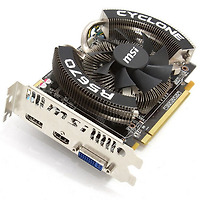Early in February we had the opportunity to show you a sneak preview of the now final product that we are testing today. The Radeon HD series 4700. Slated for a launch in late April, that article opened up a lot of eyes.
See, ATI lately is aggressive in it's product line-up, constantly adding and shifting their products, forcing their products and competition to become faster, yet cheaper. And that's just great news for us as consumers isn't it?
Today, we have another bang for buck product, a product that I like very much. As what ATI is doing today is pretty remarkable. They are releasing the Radeon HD 4770, a mainstream product at a budget price. Trust me when I say that after reading this review, you will be impressed. And here's the three step plan that ATI applied to the Radeon HD 4770:
Step one, ATI shifted the GPU fabrication to a 40nm node. The result is a product that is smaller and uses less current. With that fact in mind, you can often increase clock frequency. Then compensate heat with a dual-slot cooler, and take it up yet another notch.
Step two was to use an ASIC design based off the RV770 (Radeon HD 4850 / 4870), as such this product comes with a full 640 shader processor setup.
Three, arm the graphics card with high frequency gDDR5 memory. And while the bus width is 128-bit, they used gDDR5 and doubled up that missing bandwidth again.
Then end result, features and performance wise, is a product that roughly equals the Radeon HD 4850. And at a MSRP of 99 USD that surely does not suck. And mind you that is specifically the starting MSRP here, as we can certainly expect this product to fall towards ~80 USD / 75 EUR in e-tail in the weeks to come.
So without further ado, let's review the final product this time, the Radeon HD 4770... mainstream performance, at a budget price

Overclocking the Radeon HD 4770
This week the Radeon HD 4770 was released by ATI and as our reference article showed, it has a lot of overclocking potential. Being a budget card with a lot of punch, overall performance is to be
found in the mid-range segment. We here at Guru3D.com would like to
teach you how to get more out of your 99 USD investment. In fact we'll
show you how to get another 10 to 20% additional performance out of the
card, totally free. I mean seriously, the Radeon HD 4770 has a lot of tweaking headroom. Typically overclocking can be managed really well through the
Catalyst control center, however .. the control center always has
certain restriction as in 'how much' you can actually overclock. In this
article we'll show you how you can overclock the easy way, with the
help of this little application we make ourselves, Rivatuner. This article is really simple as all we'll show you is, how to manage
an overclock; and of course throw in a couple of additional benchmarks. So what exactly is Overclocking & Tweaking ? -- Well, as most of
you with most videocards know, you can apply a simple series of tricks
to boost the overall performance a little. You can do this at two
levels, namely tweaking by enabling registry or BIOS hacks, or very
simple, tamper with Image Quality, which you never want to do really.
Then there is overclocking, which will give you the best possible
results by far, on the fly, for free. it only takes a little time an
patience. Literally by increasing the frequency of the videocard's memory and
graphics processor, we can make the videocard increase its calculation
clock cycles per second, making it run faster. It sounds hard, but it
really can be done in less than a few minutes. A word of advise though, I
always tend to recommend to novice users and beginners not to increase
the frequency any higher then 5% (in total) of the core and memory clock
MHz. What do we need? One of the best tool for overclocking NVIDIA and ATI
videocards is our own Rivatuner that you can download from our website.
If you own an ATI or NVIDIA graphics card then the manufacturer
actually has very nice built in options for you that can be found in the
display driver properties.
'Radeon Cards' 카테고리의 다른 글
| Radeon HD 4750 review (0) | 2011.09.04 |
|---|---|
| Radeon 4890 Cyclone SOC review (0) | 2011.09.04 |
| Radeon HD 5570 review (0) | 2011.09.04 |
| Radeon HD 5670 Cyclone 1G review (1) | 2011.09.03 |
| Radeon HD 5830 Twin Frozr II review (1) | 2011.09.03 |



